› 2018 Gifted Thinking Success File: Seven Habits of Highly Effective Readers
2018 Gifted Thinking Success File: Seven Habits of Highly Effective Readers
posted by Karen Quinn, The Testing Mom - February 26th, 2018
As I was combing through some of my favorite articles, I felt like our Gifted Thinking Success File would come up short, if we failed to mention the importance of reading. This article from Brazosport College on the seven habits of highly effective readers succinctly covers all the bases. I think you will be greatly enriched by reading it. It is good for all ages of learners!
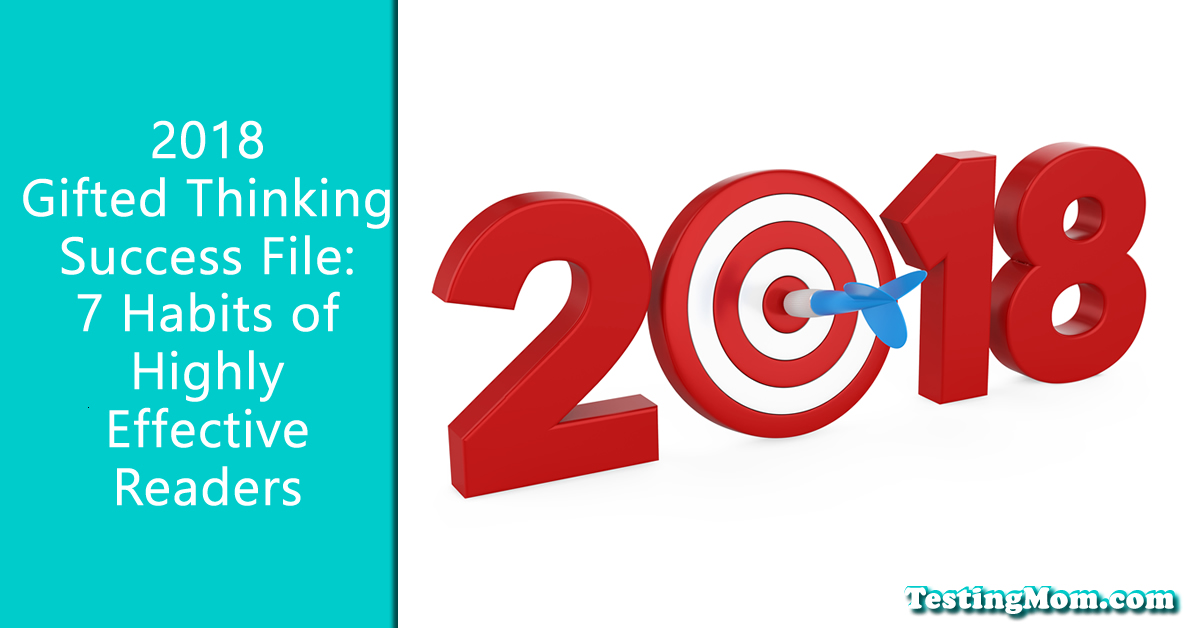
7 Habits of Highly Effective Readers
1. Effective readers have adaptable reading strategies that match different reading tasks.
The demands of the reading process change depending upon the type of reading you do. Sometimes, reading is effortless, maybe even “fun”– perhaps when you read a magazine article on your favorite hobby, a spell-binding mystery novel, or other such “recreational” reading material. At the other end of the spectrum, reading is real work: legal contracts, apartment leases, insurance policies–and some textbooks.
Effective readers are aware enough of their own interests, motivations, and abilities to realize that they can’t take the same approach to reading a difficult textbook that they would use for reading a magazine article or newspaper. An awareness of the reading task that lies ahead helps effective readers take steps to make their reading as efficient as possible, which leads us to Effective Habit 2…
2. Effective readers control time, place, and atmosphere to suit the type of reading task they face.
You may be able to read your favorite magazine or an exciting novel while you are lounging in an easy chair or lying on your bed. But the same settings can be disastrous if you are trying to read a tough chapter in your chemistry textbook. When you have a reading assignment that will be demanding of your time and energy, go to the library or move from the living room to the kitchen table. Sit in a well-lit area, at a desk or table and in an upright chair. In other words, pick a working setting to do your reading work, not a recreational or casual setting.
The same is true for controlling time. Do as much of your reading as you can during daylight hours. One researcher on a college campus concluded that students working an hour during the daytime hours get as much done as students working an hour and a half during the evening. Also, pay attention to sequencing your reading assignments. If you need to do reading in three different textbooks, start with the toughest and finish with the easiest. Don’t put off the hardest reading to the time when you are likely to be most fatigued.
As to atmosphere, difficult reading needs to be done in environments that are relatively quiet and as free from distracting goings-on as possible. Don’t kid yourself about being able to read better if a radio or TV is on. If you are struggling to read difficult text assignment, you are already having to fight the tendency to “tune out” the material. It is too easy to “tune-into” the radio or TV and sabotage the reading process.
3. Effective readers spend some time previewing the material before they begin reading it.
If you follow no other advice in this tutorial, follow this one: always preview your reading material. Reading a chapter “cold” is something like walking into a darkened room. You have to feel your way around, get your bearings, and struggle with obstacles you bump into. If you stood in the doorway, turned on the lights for just a few seconds, and then entered the room, you would have a much less difficult time.
Previewing a chapter has the same effect as turning on the lights briefly in a room. So much of your reading efficiency is based on being able to predict where the material is headed, in seeing its overall structure, and in using dozens of other clues to begin the process of relating the prior knowledge you have on the subject to what you are about to read. By spending 5 to 10 minutes in a methodical preview of the chapter, you will be able to do the actual reading with greater comprehension and at a faster reading rate. You won’t experience the slow reading that takes place at the beginning of the chapter as you try to figure out where the material is going. You won’t have the same kind of stops and starts, digressions, and re-readings that often occur when you start reading cold.
Previewing should focus on several elements that are common to almost all textbook chapters:
- Chapter title: This should be a concise statement of the topic and sometimes hints at the perspective the author is taking on it. This chapter title from an American history text indicates the focus of the chapter. When you note the title, your mind begins to make a quick inventory of what you already know about the beginnings of the labor movement in this country.

- Outlines, objectives, or formal introductions: Almost all chapters will have at least one of these elements at the beginning. They can give you a quick “skeleton” of the chapter’s structure and content. This outline from a government textbook introduces the chapter’s main headings and subheadings.
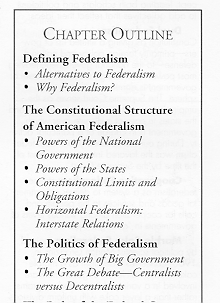
- Summaries or conclusions: Skim through these; the author almost always gives hints at what he feels are the most important ideas in the chapter.
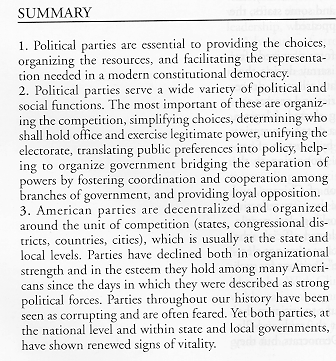
- Headings and subheadings: Most chapters will have a system of headings and subheadings that is used consistently throughout the book. In the example below, the chapter’s main division headings are in a large standard font. A little further down, a subheading in an italicized smaller print. As you page through the chapter, make a mental note of how many main divisions there are, and skim through the subheadings to get a sense of the more specific topics to be covered.

- Pictures, graphs, and tables: Take a quick peak at these visual aids to develop a little better sense of the topics covered. This illustration from a psychology text comes from a chapter on memory. Such illustrations, and the printed captions that explain them, can give you important clues to chapter content.

- End of chapter questions: These also give you a hint of what the author thinks is important in the chapter. Such questions are especially helpful to read before you tackle literature assignments. In this example, which comes at the end of Stephen Crane’s short story “The Open Boat,” the editor’s first question refers to Crane’s view that nature is “indifferent” to man. Reading that questions before you begin the short story gives you valuable insight that should result in a better overall understanding of the story’s theme.
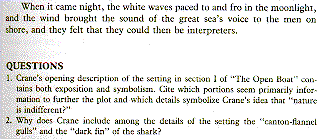
4. Effective readers know their limitations of concentration and divide chapters into manageable groupings.
It is a rare person indeed who can concentrate fully on a tough reading assignment for the 45 minutes or an hour that is required to read it. As you preview the chapter, note its overall length, and choose a couple of stopping points–ideally where the chapter moves from one main point to another–and put a post-it note or book mark at that point. Try to break up the reading into 15-20 minute blocks. When you reach a stopping point, take a few minutes break, get up and stretch, or find some other brief diversion to let your mind relax. Then go back and read the next block. Your overall comprehension will be much better.
5. Effective readers improve their comprehension by trying to read faster.
That’s right–trying to read faster can actually lead to better comprehension. We often fall into patterns of mental activity that are well below our peak ability. Let’s illustrate this point with an analogy.
Would you be a good driver if you puttered down a major highway at 50 miles an hour? Probably not, because at that speed you don’t have to focus much on the act of driving itself. Instead, the mind focuses on the passing scenery, on finding a better radio station, or perhaps on conversations with passengers. Driving is only a part of what your mind is focused on at that time. But what if you really had to get somewhere in a hurry? Now you are driving down that same road at, or maybe even a little above, the legal speed limit of 70 miles an hour. Chances are, both hands are on the wheel, your senses are sharp, and you frequently check your mirror for possible hazards. The radio gets turned down, and your mind is almost completely focused on driving.
The same phenomenon occurs with our reading. If we read at a lazy, habitual pace, our mind isn’t challenged, and it is easier for it to drift away from the task of reading and focus instead on what’s going on around us or on some nagging thought that keeps asserting itself on our attention. If, on the other hand, we consciously try to increase our rate to the point that our mind stays focused on reading, we should be doing a better job and doing it much more efficiently.
The key is not to make reading a frenzied activity, just a focused one. By consciously trying to read perhaps 10%-20% faster, the task becomes challenging enough to demand our mind’s full attention. And it has the benefit of helping us finish the task just that much faster.
A quick warning: this strategy will work with much of the reading that you have to do, but not all of it. It won’t work and shouldn’t be used when you are reading highly technical material or material that you have little experience with. Such reading is already demanding enough to require your brain to stay focused, and you won’t gain anything by picking up the pace of reading.
6. Effective readers interact with the text by highlighting important information.
Highlighting important details in the text is a good idea for a couple of reasons. The most obvious and practical reason is that it helps us distill the information down into its most important ideas and leaves us with material that we can review quickly and efficiently. But the second reason is that highlighting makes us a better reader and improves our comprehension. Even if we never look at the highlighted material again, we should remember it better. Highlighting forces us to think actively and make critical judgments. It keeps us from being passive readers, like those times when our brain goes on auto-pilot, our eyes keep moving across the page, but our mental focus is directed at that last piece of apple pie in the fridge. The highlighter keeps us focused on the task at hand.
One error students make is in highlighting too much of the material. If you look at some students’ books, half of the page or more is highlighted. Below is a page from a book that illustrates that the student highlighted too much of the material.
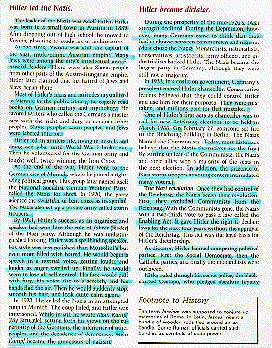
A good goal to shoot for is to limit yourself to marking 10-15% of the material. This makes you be especially discriminating as you evaluate the material. And the nice thing about it is that if it took you an hour to read the chapter, you should be able to review its important (highlighted) points in just 6 to 9 minutes if you were able to limit highlighting to 10-15%. The example below indicates that the student was more selective in highlighting, picking only the key thoughts from a page so the material could be reviewed quickly and effectively.
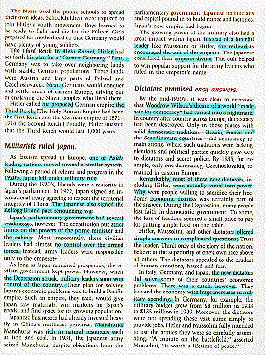
7. Effective textbook readers use recitation to reinforce what they have just read.
Many readers are so relieved when they finish the last page of a grueling chapter that they immediately close the book and go on to more pleasant activities. But investing just five more minutes in a process called recitation can save them time and effort later on.
Recitation, as the term is used here, describes the process of summarizing aloud the key points you just read in the chapter. Newly acquired information is fragile; if we aren’t careful, it can melt away as easily as an ice cube in summer heat. Recitation is a powerful tool that can help us move the information into a category of memory that is much more permanent. (For more information on memory and how it works, you can follow this link to Memory Management)
We handle this step by turning back to the first page of the chapter and reciting from memory the key ideas we just read. It is important that you do this process aloud, because it forces you to take the abstract thoughts in your brain and translate them into your own words. This translation process is important in helping you “stake a claim” to the information. As you move through the chapter and note the highlighted sections, just “talk your way” through the material a page a time. This act of reinforcing the information and expressing it in your own words will increase the likelihood that you will remember it and ensures that your review before a test is productive.
This article is shared with thanks to Brazosport College.
2018 Gifted Thinking Success File Series:
2018 Gifted Thinking Success File: Student Choices that Make the Grade
2018 Gifted Thinking Success File: Motivation and Goal Setting
2018 Gifted Thinking Success File: Memory and Learning Styles
Join us next time in our Gifted Thinking Success File, where we’ll finish up by discussing more on Identifying Your Best Learning Styles!



Tell us about your experiences